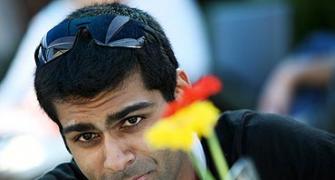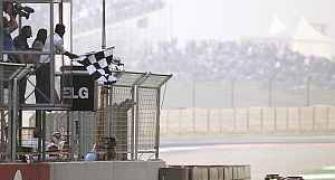German architect Hermann Tilke, who designed the Buddh International Circuit for the inaugural Indian F1 Grand Prix, said it was a big challenge to get the track ready in time and he was afraid of missing the deadline.
"You had to be afraid of course, as the last asphalt layer was done later than usual. But everything worked out fine and the show was the best possible. We started the design four years ago. But construction only started two years ago," Tilke said.
"This land was very flat. We had to bring in the earth to make elevations. It was not logistically difficult but, more a challenge in terms of time.
"In the end, we were running out of time and then it became a big challenge. But high technology and quality was there... so the difficulties were mastered by Jaypee group (the organisers of the race)," he said.
The 54-year-old architect has also designed the tracks in Sepang Malaysia - 1999), Sakhir (Bahrain - 2004), Shanghai (China -2004), Istanbul Park (Turkey - 2005), Valencia (Spain - 2008), Yas Marina (Abu Dhabi - 2009) and Yeongam (Korea - 2010).
Additionally he has made a good number of renovations to existing circuits (the Red Bull Ring in Austria, Barcelona in Spain, and the Nürburgring and Hockenheim circuits in Germany).
The inaugural race, on Sunday, was a success with Red Bull's double world champion Sebastian Vettel winning his 11th race of the season. 95,000 fans turned up for the race which also had a generous sprinkling of Bollywood star and sporting icons such as star cricketer Sachin Tendulkar.
"We are very happy that F1 is here and that we made it happen. It was very tight and it was a big challenge in the last few weeks and months, To be able to have it ready like we have it now is simply fantastic," said a relieved Tilke.
Elaborating on how the track was put together, Tilke recalled the four years of toiling that went into its construction.
"When we saw the land four years ago for the first time, it was a flat land and we asked our client Jaypee group to move some soil and some earth to get the land hilly so that we could design a track with a special character.
"Thankfully, they accepted to do it and agreed. We were able to move about four million cubic meters of soil. We wanted to make it very interesting which the drivers would like very much," he said.
Tilke said the elevations make the BIC a challenging track.
"It is like if you get into a third dimension. The car will be much lighter when you get to the very top of the bump. It makes it more interesting. With a flat track only, you are in just two dimensions, but with elevation you enter in a three dimensional system. It makes it more difficult and challenging," he explained.
"What is very special in this track is that the drivers can make easy mistakes in a long race. In a way with a difficult and perfect track we tempt drivers and expose them to easy mistakes. This is what we wanted to achieve.
"We wanted to make it difficult. I have been watching the mistakes. It shows that it is a really difficult track. But these are the best drivers in the world who can put on the best show for spectators," he added.










